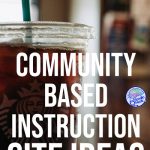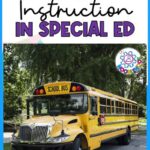Racking your brain for meaningful places to go in the community as part of extending classroom instruction? Get community based instruction ideas here and more!
Are you a SpEd Teacher racking your brain for community-based instruction ideas? Are you trying to think of meaningful places to go in your community as part of extending classroom instruction? Learn more about partnering real-life experiences with community learning opportunities for students with significant disabilities.
If you are a special ed teacher, then your brain is always spinning! You’re thinking of your students and how best to prepare them for the future. Community-Based Instruction (CBI) plays a large role in getting students ready for transition. I remember my first CBI trip. I was just glad to get all my students to the site safely and not to leave anyone behind!
When you’re first starting out as a SpEd teacher, it’s the little things, right?
After a few trips I realized I wanted to make my CBI more meaningful. Let’s face it, a group of six students working from one grocery list and then going as a gaggle to the cashier is not real life. That’s when I had to sit down and reassess the purpose of CBI.

3 Phases of Community Based Instruction
If you are wondering about the larger purpose of your CBI trips, it helps to think of them in three phases.
Phase 1: Campus Based Trips
In the very beginning, your “community trips” may well be trips through your school community. When you’re working with students who have significant disabilities, it’s not uncommon for them to be sheltered throughout their school day (only interacting with their one teacher and small group of classmates). On top of that, when you think about it, a typical school campus is almost like a mini city! We can use these two things to our advantage.
Having students out in the school community interacting with places and people that are not typical to their academic day is a great way to practice prerequisite skills for CBI trips. With places like the nurse’s clinic, food service, administrative offices, maintenance, and so much more, you’ll find there’s plenty to experience right inside your own building.
As far as the skills you’re addressing in these environments, stick to the basics. Work on things like communicating with others, listening to adult directions, navigating with independence, and completing one or two step tasks. These skills all set the foundation for being successful when out in the larger community.

Phase 2: Community Based Instruction
Community Based Instruction trips push our students out into the greater community. These trips, however, are not field trips. Just to clarify, a CBI trip has fewer students, aligns with a student’s IEP goals by way of supporting their transition plan, and typically targets a well-defined objective. A field trip on the other hand is more about fun, connecting to the current curriculum, and tends to have larger groups. Both have a purpose for students, but a CBI trip is a functional way to practice life skills.
When planning CBI trips for your students, you’ll target local community sites. See below for more community based instruction ideas on where you can go in your community.
Phase 3: Vocational Community Training
Being out in the community is so much more than just being a consumer. Some of our students are preparing for a life that includes a steady job. In order to prepare for that, students may participate in Vocational Community Training. So many young people today are unable to keep a job because of deficits in underlying soft skills (time management, customer service, attending to task). By taking your students out into the community to do vocational training, you allow them to practice work skills while under the supervision of a job coach (the teacher).
Typically, Vocational Community Training provided during the school day by a teacher consists of volunteering at a local business. Although students are not paid for their work, the vocational training that occurs is truly priceless. Training sites could include local libraries, retail establishments, manufacturing companies, healthcare facilities, or tourism sites. Really, any local business has the potential to be a fantastic vocational training site, so long as management is willing to support students with disabilities.
Categories of Community Based Instruction
Now that we have reviewed the three phases of Community Based instruction, let’s talk about some Community Based Instruction Ideas for your students.
Site Category 1: Retail
When most teachers plan Community Based instruction trips, they target retail sites. It makes sense! As a consumer, most of our time and money is spent at retail stores.
As we prepare students for life after K-12, we have to be mindful that it might include group home or facility living. Those types of places fill a huge gap to provide care for people with disabilities. Part of their typical programming includes outings to local retail stores. Helping our students practice independence in those settings really does set them up to be successful post-secondary.
So, remember the purpose of a trip like this. It is not to go through a store in a huge gaggle. It’s to develop a skill set to allow a student to be dropped off at the front door and picked up at that same front door with all of the things they needed. A great example is shopping for toiletries at a local pharmacy. Getting dropped off at the front of Walgreens with that targeted shopping list in mind and being able to navigate, make decisions, pay for items, and make it back to the front door to meet your ride with as much independence as possible becomes a critical life skill.
Some sites you may consider include:
- Big box department stores, like Walmart or Target
- Pharmacies, like Walgreens or CVS
- Grocery stores
- Specialty stores, like Best Buy or PetSmart
- Dollar stores, like the Dollar Tree or Family Dollar
Read More: Vocational Targets for Students with Autism, Vocational Training with Gift Cards, and How to Setup a Coffee Cart
Site Category 2: Restaurants
Most people make at least one trip to a restaurant every week. Typically, it’s to a fast food restaurant to grab a snack or a quick meal. Not quite so commonly, we dine at a sit-down restaurant. Either way, when you go to a restaurant, there is a very specific skill set you need to have. You have to be able to decide what kind of restaurant you’d like to eat at, order at that restaurant correctly, budget your money so you have enough for what you want, pay for your meal, and dine with some independence. Depending on the situation, dining may include social interactions. You may also need to have the skills necessary to use a public restroom.
With all this in mind, there’s a lot of skill development that can be done at local restaurants as part of Community Based Instruction for students with disabilities. Some sites you may consider include:
- Local fast food, like McDonald’s, Chick-fil-A, or Taco Bell
- Sit down restaurants, like Buffalo Wild Wings or Applebee’s
- Counter restaurants, like Donut Shops or Subway

Site Category 3: Daily Living Sites
By far, the first two categories make up the bulk of community sites a student needs to master as part of Community Based Instruction. There are, however, other places that are often specific to students with disabilities or specific to students inside of certain communities. No matter what specific sites fall into this category, the underlying skills that a student needs to be successful are similar. Those include things like map navigation, asking for assistance, being able to wait patiently (in line or in a waiting room), and being able to manage money. With these skills in mind, some sites you may consider include:
- Self-Care sites, like a Laundromat, Doctor’s Office or Hospital
- Financial sites, like a bank or post office,
- Entertainment sites, like a bowling alley, a movie theater, or mall
Where Do You Start?
A lot of Community Based Instruction ideas were mentioned in this post and podcast. Not sure where to start when it comes to curating a list of places to go for CBI trips? Start with a list of community sites in your own community that get a lot of traffic. Where is everyone else going?
Second, make a list of places you personally go in a given week or month. Which places do you go to most often? Finally, consider the places in your community that are most popular either for people in their twenties or for people who live in group homes or care facilities. If you know that the local home typically takes its residents to Wal-Mart and Wendy’s, then those are the best places for you to start.
The community site is NOT the most important thing about CBI trips.the most important thing it’s to increase independence and deepen the complexity of tasks a student can complete within the community. The goal of CBI trips to make students successful as they transition to adult living and to do so with minimal support. You could take every CBI trip to the same grocery store in still make that trip more dynamic based on what you’re asking the students to do. Keep asking yourself if you can make a task more complex for students and how you can support them without making them more dependent on you.

What is a Community Based Activity?
Reading this article may have given you some great ideas as to where you can go for Community Based Instruction trips, but you might not be sure of what to do once you’re there. Here are two great examples of community activities for students with disabilities.
First off, try the CBI Scavenger Hunt Task Cards. I’ve used these over and over again in the community with an array of students. These cards come with multiple skill levels in mind, making them perfect for addressing individual needs at a single site. Also, because they are relatively generic, they worked at several different types of community retail sites. You can check those cards out here.
Secondly, if your students still need lots of practice in the classroom before your CBI trips, try the Grocery Store Flyer Task cards. They work with most store flyers and help students work on the underlying skills needed to make them more successful during CBI trips. Check those out here.
Finally, if your students need help with menus, budgeting and money math, try this Menu Math Activity (my favorite is Chick-Fil-A)!
Community Based Instruction Ideas for Students with Disabilities
There you have it, the purpose of CBI trips, the three phases of CBI (campus-based, community-based, and vocational training based), as well as ideas for places to go for CBI (retail, restaurant, and daily living sites).
Stay strong and teach on!
CBI FAQ
Community-Based Instruction (CBI) is an approach to teaching functional skills to special education students in a natural setting. It involves taking students out of the school setting and into the community to teach them real-life skills that will help them live more independently.
CBI is particularly helpful for special education students with a wide range of disabilities, including intellectual and severe disabilities. However, it can be beneficial for any student who needs to learn functional skills in a real-world setting.
CBI can be implemented through systematic instruction, data collection, and target goal setting. Special education teachers and staff members can also use picture cues and communication devices to help students learn different skills in different environments. It’s important to involve students’ parents and use community resources to ensure program implementation is successful.
CBI provides students with real-life experiences and helps them develop important skills that will help them live more independently. It can also help students prepare for post-secondary education and post-school activities. Additionally, CBI can be an enjoyable way for students to learn and engage in leisure activities.
CBI experiences may require some extra costs, such as public transportation or admission fees to certain community locations. However, many community resources are free and accessible to everyone. It’s important to plan short trips and use community resources to minimize costs.
It’s important to choose age-appropriate experiences and ensure that students’ medical needs are met when you’re in the community. Incorporate favorite places and make them a part of IEP goal targets. Special educators can also use a walking trail and safe community routes to teach self-help skills like crossing the street. Finally, involving store managers and community members in the program can help students feel more comfortable and confident in their abilities.
Community-Based Instruction can be an effective way to teach social skills to special needs students. By taking students on community trips and outings, they can practice communication, turn-taking, and problem-solving skills in a real-world setting. Sit-down restaurants and scavenger hunts, for example, can provide opportunities for students to practice appropriate behaviors and social interactions.
Yes, Community-Based Instruction is appropriate for students of all ages, including high school and middle school students. Older students may benefit from experiences that focus on vocational education and job sites, such as visiting a local Home Depot or shadowing a staff member at a favorite local business. Middle school students can learn age-appropriate skills like using a debit card or ordering food at a fast-food restaurant.
Community-Based Instruction experiences can be incorporated into the school day by planning short trips to local parks, sit-down restaurants, and other community locations that are within walking distance of the school. If going further afield is required, virtual field trips can be used as an alternative. By involving community participation and store managers, students can learn functional academics and real-life experiences during school hours. Direct instruction and the use of communication devices can also help ensure that students with intellectual disabilities can fully participate in these experiences.
We have a lot of activities in the Noodle Nook store, including these winners:
These are a great place to start with activities in and out of the classroom that support CBI and community-referenced activities



